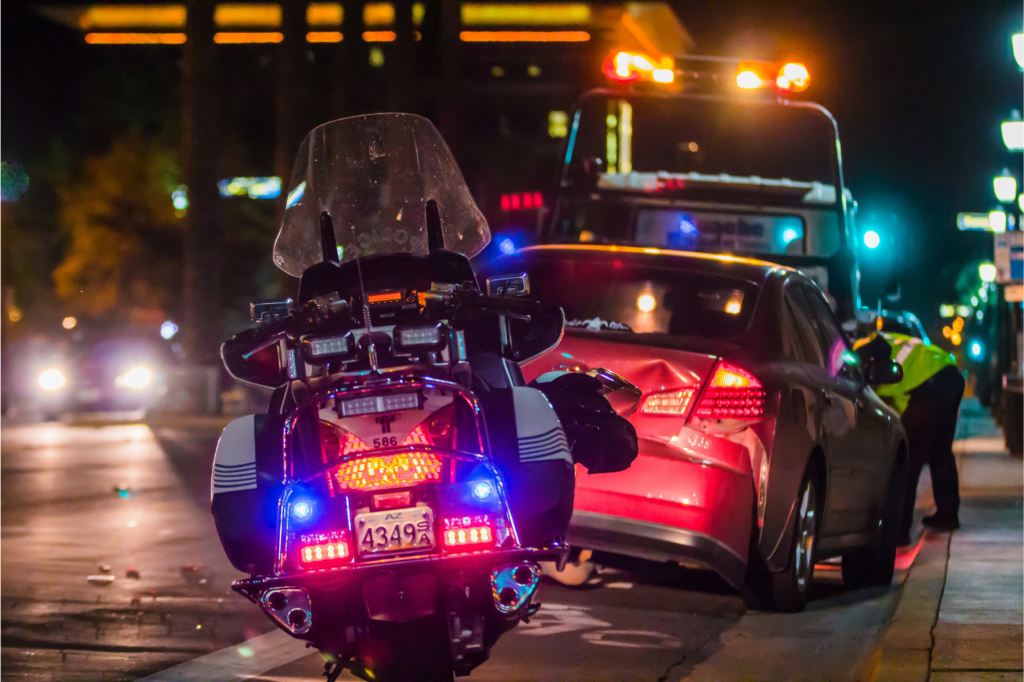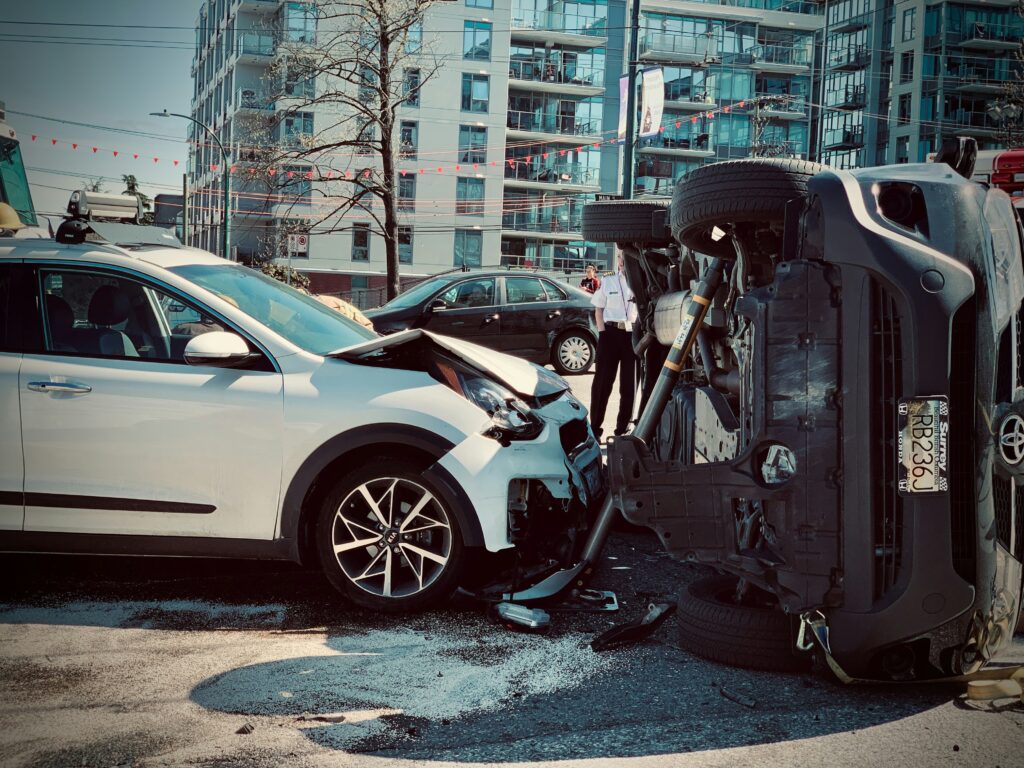7 Common Types of Car Crashes
How They Happen, And Who Is At Fault
Do you need an experienced car crash lawyer near you? Get a free case evaluation.
Any type of vehicle collision, from a single-vehicle crash to a multi-car pileup, often creates a tremendous amount of stress and confusion in the lives of those involved. With more than 30 years of experience representing people injured in car accidents across New Jersey, we recognize that different types of car accidents involve slightly different profiles. While no two car accidents are exactly the same, we understand that similarities do emerge depending on the type of accident.
In general, there are two types of car crashes: single-vehicle crashes and multi-vehicle accidents. A single-vehicle accident involves only one car; the vehicle may run off the road, hit an object like a tree or guardrail, or roll over as a result of speeding, drowsy or impaired driving, inclement weather, or swerving to avoid an obstacle. Mechanical failures or road hazards can also play a role. A multi-vehicle accident involves two or more vehicles, often for the same reasons listed above.
Here, we discuss the most common types of bad car crashes, along with an explanation of how they typically occur and who is usually at fault. Please note that some accident types may overlap and that this information is not meant to be taken as legal advice.
Rear-End Collisions
A rear-end collision occurs when one vehicle crashes into the back of another. These can result from driver inattention, slick roads, excessive speed, driving under the influence, or any combination of these factors.
Rear-end crashes can happen when the leading car slows down or stops suddenly, and the trailing car does not have enough time or space to stop. Common causes include distracted driving, tailgating, or sudden braking in heavy traffic. Most rear-end collisions could have been avoided if the trailing car had been traveling at a safe speed and distance, but exceptions do occur; if the driver in front swerves or drives in an erratic way, this makes a rear-end accident more likely.
In most cases, the trailing vehicle is at fault for failing to maintain a safe following distance. However, there can be exceptions; if the leading car’s brake lights were not working, if the road was suddenly slick, or if the front driver stopped abruptly for no reason, this may present a situation of comparative fault.

Head-On Collisions
A head-on collision occurs when the front ends of two vehicles collide with each other. Because this type of collision involves two vehicles traveling in opposite directions, and because the impact speed is additive, head-on-collisions can result in serious injuries to both drivers.
Head-on collisions often happen when one vehicle drifts into the opposite lane; this can result from distracted driving, drowsiness, impaired driving, or slippery road conditions. They are also common in wrong-way driving situations, where a vehicle travels against traffic flow on a one-way road. They may also be the result of a mechanical issue.
Typically, the driver who crosses into oncoming traffic is at fault. In some cases, the other driver may share fault if they were speeding or otherwise contributing to the conditions that caused the crash. In some cases, a third-party driver may bear some responsibility if they force a driver into the lane of oncoming traffic.
Side-Impact Collisions (T-Bone)
A side-impact collision, or “T-bone collision,” occurs when the front of one vehicle strikes the side of another, forming a “T” shape. (This is not to be confused with a sideswipe collision, which occurs when two vehicles traveling parallel to each other make contact along their sides.)
Most side-impact accidents occur at intersections when one driver fails to yield the right of way. They may run a red light, or ignore a stop sign, or be pushed into traffic after another car rear-ends them. Side-impact collisions can also happen in parking lots or during lane changes.
In most side-impact collisions, the driver who failed to yield the right of way is at fault. However, liability may also depend on other circumstances, like the behavior of the other driver, road conditions, or unusual circumstances of the accident.

Vehicle Rollover
Vehicle rollover accidents are serious events that often require emergency medical services. A rollover occurs when a vehicle tips over onto its side or roof; the vehicle may also roll several times before coming to a stop. Wearing a seat belt is among the most important ways to mitigate medical damage in a rollover collision.
Rollovers can happen during high-speed turns, sharp maneuvers to avoid an obstacle, or when a vehicle hits a curb or object. Rollovers can be single-vehicle or multi-vehicle; they often involve SUVs and trucks, which have higher centers of gravity and are more prone to rollovers. Rollover accidents may also result from mechanical issues.
The driver is usually at fault for driving too fast, making sharp maneuvers, or losing control. However, if the rollover was caused by a road hazard or a defect in the vehicle, liability may shift to the government entity responsible for road maintenance or the vehicle manufacturer. In any rollover accident, it is critical to speak to a car accident attorney to understand your legal options.
Highway Accidents: What You Need To Know
While car accidents can happen anywhere, highway or turnpike accidents can be particularly dangerous. Due to the increased speed and proximity to other vehicles, highway accidents often involve several types of car crashes, including blind-spot accidents, rear-end collisions, side-impact collisions, rollovers, and more. They may also involve larger vehicles, including semi-trucks.
If you were involved in a collision on a highway, interstate or New Jersey turnpike, call the car accident attorneys at Arlen Law Firm: 908-212-7660.
Free Case Evaluation
Hit-and-Run Collisions
Hit-and-run collisions are often tragic occurrences in which a driver causes an accident but then leaves the scene without stopping to provide information or assist those involved. While some hit-and-run events involve parked cars, others can involve manned vehicles. The injured party may not be able to track down the responsible party and will be forced to pay for their medical bills out of their own pocket.
These incidents often occur in parking lots or in minor accidents where the at-fault driver fears legal repercussions. In some cases, hit-and-run drivers flee to avoid charges for other infractions like DUI or driving without a license. In serious accidents involving broken bones or similar medical issues, the driver may not be adequately insured and is afraid of the financial consequences.
If someone else hits your vehicle and left without giving their information, call the police immediately and provide as many details about the other driver’s vehicle as possible. Always contact your insurance company to report the incident, and see a doctor as soon as possible to ensure you receive appropriate medical attention.
The fleeing driver is at fault for failing to stop, regardless of who caused the collision.
DUI Accidents
DUI accidents involve one or more drivers who are impaired by alcohol or drugs, including both illegal substances and prescription medications. Drug use leads to reduced reaction times, impaired judgment, and decreased coordination.
DUI accidents can happen in a variety of situations. A drunk driver may veer into oncoming traffic, causing a head-on collision. The delay in reaction time caused by the drug may result in the driver ignoring stop signs, red lights or failing to yield; this can lead to T-bone or rear-end accidents. Finally, impaired drivers have slower reaction times; this can lead to rear-end collisions if they fail to stop in time.
The driver under the influence is almost always at fault. New Jersey DUI laws hold impaired drivers strictly liable for accidents caused by their impairment, regardless of other circumstances. If the DUI driver was not the one who directly caused the crash, their impairment can still affect their liability or legal consequences.
Blind Spot Accidents
Blind spot accidents occur when a driver fails to notice another vehicle in their blind spot and makes a maneuver, such as changing lanes, merging, or turning, that results in a collision.
Blind-spot accidents often happen during lane changes when the driver doesn’t properly check their side or rearview mirrors or fails to turn their head to check the blind spot. They can also occur when drivers merge onto highways or turn into a different lane without signaling or ensuring that the lane is clear. In larger vehicles, like trucks and SUVs, blind spots are more significant, leading to a higher likelihood of these accidents.
The driver who failed to check their blind spot before changing lanes or merging is usually at fault. In some cases, the fault could be shared if the other driver was speeding, driving aggressively, or in the process of overtaking in a manner that made it difficult to see.
Have you been involved in a car crash? Call Arlen Law Firm: 908-212-7660
Our Somerset County car accident lawyers are here to help to make even the most complicated case simple. We offer free case evaluations and a contingency fee payment structure, which means you don’t pay us until we collect money for you.
